English
Transportation In and Between Islands
- Details
- Created on 17 February 2013
- Last Updated on 13 May 2013
Upon Arrival
In case you have heavy luggage you may ask some help from the carriers on the Pier. They can take your luggage to your house/hotel.
You should ask about the fee in advance. Prices change depending on on the load and destination.
Transportation in Islands
Phaeton (Horse carriage)
You can find the Phaeton terminal near the Piers at Büyükada, Heybeliada and Burgazada. It is compulsary that the price list should be hanged in the terminal and in the Phaetons. Please ask the prices in adavance...
Transportation Between Islands
Please look at the schedules. You may use Mavi Marmara boats or Şehir Hatları ferries between islands.
Getting to the Beaches
In all islands special boat services are available for transportation to the beaches. These boats can be found near the main piers.
In general, transportation fee is included in the entrance fee. You can also use the same boats for your return.
Bicycle
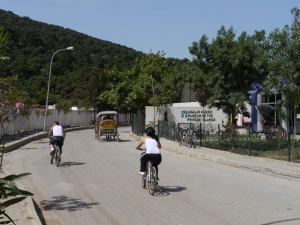 You can rent bicycles from around the center of the islands.
You can rent bicycles from around the center of the islands.
Please ask about the rules of renting and driving the bicycle and follow them carefully. Do not allow this delightful trip to become a nightmare for yourself and others.
Rent a Boat or Yacht at Adalar
Phones, Useful Web Sites...
Transportation to Museum of The Princes' Islands
Museum of the Princes’ Islands is the first contemporary city museum of Istanbul. It tells the story of the Islands from the geological formation of the Islands to the present day, displaying hundreds of objects and utilising twenty thousand Ottoman archival documents, six thousand digital photographs, hundreds of documentary films, documentation and filming of today’s Islands, archival records of public institutions of the Islands, temporary and permanent donations of the Islanders.
You can reach the Museum by walk (about 20 minutes from Center) by bicycle or by phaeton.
Taking Pets to Islands
You may take your pets and tour together in Islands. However you should follow the rules in the means of transport. You should have your pet in a cage and mouth collar. Your pet may travel only in open areas of the boats. Also you should bring a bag to collect the excrement of your pet.
Note to interested: In Büyükada there is a dog shelter at Aya Nikola Square near Museum of the Princes' Islands. There you may find several dogs abondened in the forest. Want to vis,t them? (Please see the map)
How to get to the Islands?
- Details
- Created on 18 February 2013
- Last Updated on 08 May 2013
By sea of course.
There are scheduled trips from both sides of Istanbul everyday of the year.
From the European side: Big boats take off mainly from Kabataş and from eminönü from time to time, the City Lines' traditional boats and IDO's catamarans organize regular trips to the Islands.
From the Asian side: Big boats take off mainly from Bostancı and additionally from Kartal and Maltepe. The City Lines' traditional boats are also available from Bostancı.
Furthermore you can call on a seataxi from either side of the Bosphorus. Even though you will wait for a while and that the prices are not at the same level as the regular boat trips, the seataxis will take you to the islands in a relatively short span of time.
As for the transportation on the islands there are a few different options. You will either choose to walk or hop on a horse carriage, if not you can always rent a bike. If you want to go to another neighbouring island ou can do so by taking one of the boats owned by private companies or the City Lines.


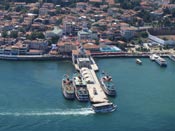
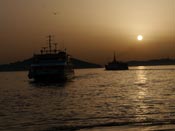
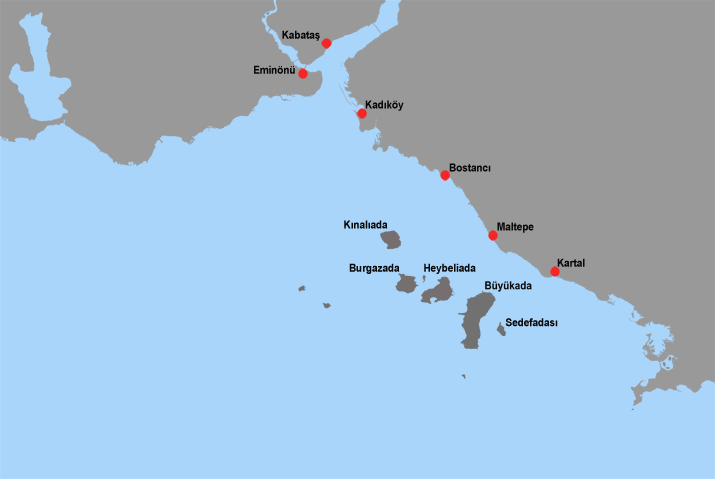
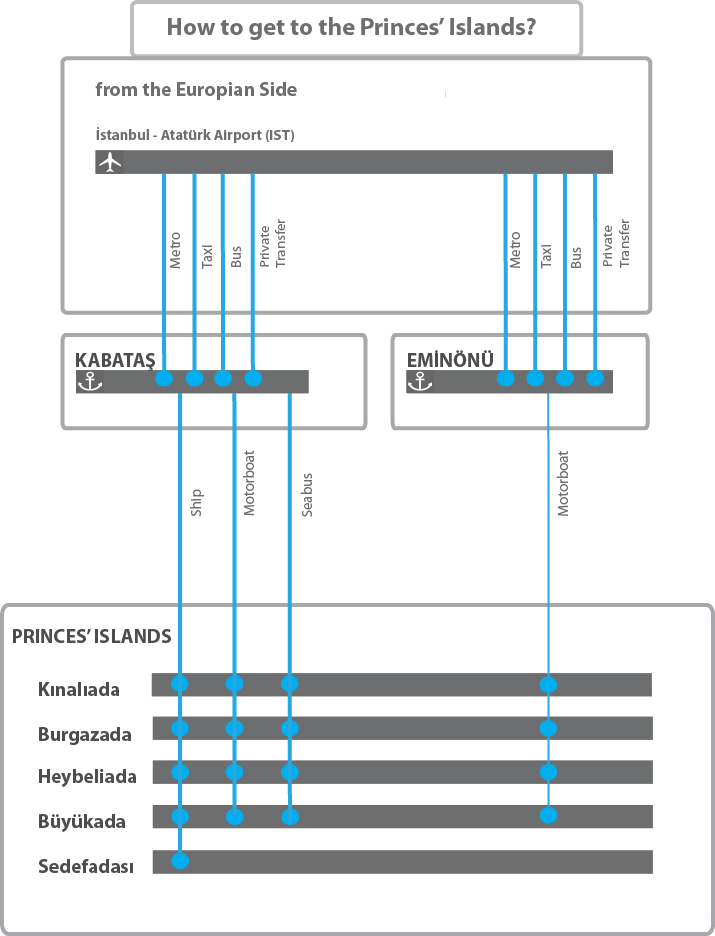
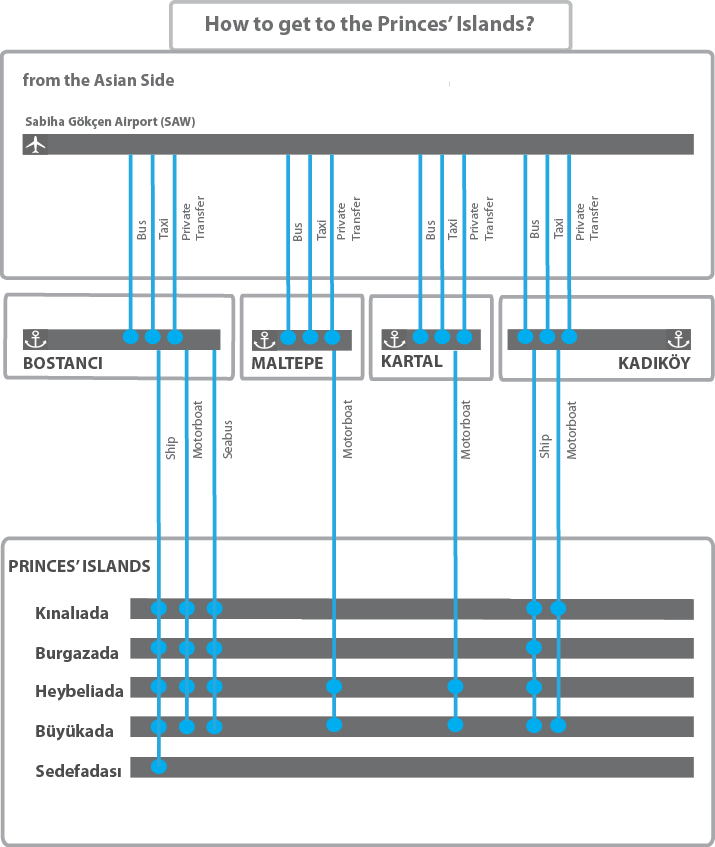
European Side:
If you have landed at the Istanbul Atatürk Airport, depending on the traffic, it will take you between 45 and 90 minutes to get to Kabataş by car. Alternatively you can make use of the City's public transportation system and get to Kabataş by using the subway, funicular, tram and buses. If you have just missed the boat at your arrival you can always relax and enjoy a cup of tea at the shore.
Kabataş is a big harbor. Where you find the IDO catamarans, the City Lines' boats and other piers of various sizes side by side. It is possible to get to many different destinations in Istanbul by sea. Timetables are shown on each pier. You can look at these timetables to get to the Islands. Or you can click here to learn more about the scheduled trips.
Asian Side:
You can fetch a bus ride from the Sabiha Gökçen Airport to bostancı organized by Havaş and havataş. Bostancı, is a central harbour to reach many places in Istanbul including the Islands. The City Lines, Mavi Marmara and IDO piers are all lined along the coastline. The schedules can be found on the piers. Alternatively you can learn the timetable by clicking on the link below.
TRANSPORTATION SCHEDULES
Here you can find the schedules of the boat rides depending on your point of departure and arrival.
These timetables change twice a year. Different schedules are organized during winter and summer. There also may be temporary changes to these schedules depending on the weather conditions
We aim at giving you only the most up to date schedules. Nonetheless we suggest that you check the cmpanies' websites for the earliest and latest boat rides from and to the Islands.
COMPANIES
Mavi Marmara : http://www.mavimarmara.net/
City Lines : http://www.sehirhatlari.com.tr
İDO : http://www.ido.com.tr/
Dentur : http://www.denturavrasya.com/
Prenstur : http://www.prenstur.net/
Turyol : www.turyol.com
SEATAXI
You can order a private boat from the seataxis any time of the day. During the busy summer season it may take a bit longer for the seataxis to arrive at your point of departure. Please ask for the time of arrival and the price for the fair, the first time you call the seataxi.
Süvari Seataxi
İDO Seataxi
Private boat reservationfor groups larger than 10:
Mavi Marmara
A small hint:
If you sit on the right side of the boat while coming to the islands you may enjoy the view of our archipelago during all your trip..
CONTACT INFORMATION
| Organization | Phone | Fax | Web | |
| City Lines Head Office | +90 212 313 80 00 | +90 212 253 94 75 | www.sehirhatlari.com.tr | This email address is being protected from spambots. You need JavaScript enabled to view it. |
| City Lines Kabataş | +90 212 444 18 51 | |||
| City Lines Büyükada | +90 216 382 60 06 | |||
| City Lines Heybeliada | +90 216 351 84 37 | |||
| City Lines Burgazada | +90 216 381 13 17 | |||
| City Lines Kınalıada | +90 216 381 40 20 | |||
| City Lines Customer Services | 444 18 51 | |||
| İDO Head Office | +90 212 455 69 00 | +90 212 517 39 58 | www.ido.com.tr | This email address is being protected from spambots. You need JavaScript enabled to view it. |
| İDO Kabataş | +90 212 243 56 12 | |||
| İDO Bostancı | +90 216 410 66 33 | |||
| İDO Büyükada | +90 216 382 44 36 | |||
| İDO Heybeliada | +90 216 351 15 03 | |||
| İDO Burgazada | +90 216 381 28 40 | |||
| İDO Customer Sevices | 444 44 36 | |||
| Mavi Marmara Customer Services | 444 20 39 | www.mavimarmara.net | This email address is being protected from spambots. You need JavaScript enabled to view it. | |
| Mavi Marmara Bostancı | +90 216 464 29 30 | |||
| Turyol Centre | +90 212 251 44 21 | +90 212 251 96 74 | www.turyol.com | This email address is being protected from spambots. You need JavaScript enabled to view it. |
| Turyol Eminönü | +90 212 527 99 52 | |||
| Museum of Princes' Islands | +90 216 382 64 30 | +90 216 382 58 42 | www.adalarmuzesi.org | This email address is being protected from spambots. You need JavaScript enabled to view it. |
| Islands Municipality | +90 216 382 3 382 | +90 212 381 76 61 | www.adalar.bel.tr | This email address is being protected from spambots. You need JavaScript enabled to view it. |
| İDO Seataxi | 444 44 98 | |||
| İDO Seataxi Head Office | +90 212 615 62 62 | +90 212 616 54 24 | www.deniztaksi.com.tr | This email address is being protected from spambots. You need JavaScript enabled to view it. |
| M.Marmara D.T.Süvaribey Boat | +90 545 445 72 80 | |||
| M.Marmara D.T.Mavimarmara Boat | +90 545 445 72 72 | |||
| Heybeliada S.Ü.Kooperatifi (Liman) | +90 216 351 96 30 | +90 212 351 83 73 | ||
| Heybeliada Couch Station | +90 216 35113 90 | |||
| Heybeliada Porter Head (Mehmet Yıldız) | +90 536 263 82 95 | |||
| Büyükada Coach Stattion | +90 216 382 59 39 |
Practical Information
- Details
- Created on 17 February 2013
- Last Updated on 01 April 2013
Health
Medical Emergencies:
Büyükada has a hospital and health clinic. Each of the other islands has a clinic, and Heybeliada also has a polyclinic specializing in chest ailments. Büyükada Hospital has eight doctors, including four specialists. Heybeliada’s polyclinic has a team of medical specialists, and the other islands’ clinics are staffed by general practitioners. During the summer months, the clinics have practitioners on duty around the clock. Each island has ambulance service within the island, and an ambulance boat is available for emergency transport to the mainland.
Telephone numbers:
Büyükada State Hospital: (216) 382 62 28
Büyükada Health Clinic: (216) 382 62 10
Heybeliada Health Clinic: (216) 351 88 50
Burgazadası Health Clinic:: (216) 381 19 19
Kınalıada Health Clinic: (216) 381 40 60
Pharmacies:
There are drugstores on the four main islands: Büyükada, Heybeliada, Burgazadas›, and K›nal›ada. Weekday hours are 08.00-18.30 in winter and 08.00-20.00 in summer. Each island has one pharmacist on duty for emergencies at night and on Sundays and official holidays. The name of the pharmacist on duty is posted in the window of all pharmacies.
Tipping
A five to fifteen percent tip is customary for staff at hotels, restaurants, Turkish baths and hairdressers.
Post Office, Telephone and Internet Services
Post and Telephone:
Post offices can be identified by the letters PTT on a yellow background. The PTT also provides telephone, telegram, and fax services. Büyükada’s main post office, on Recep Koç Caddesi, is open twenty-four hours a day, seven days a week. On other islands, the post office follows government office hours.
The telephone area code for the Princes’ Islands is 0216, same as the Asian side of Istanbul. The code for the European side of Istanbul is 0212.
Internet:
There are Internet cafes on Büyükada and Heybeliada. On Büyükada: near Çınar Meydanı. On Heybeliada: just off Lozan Zaferi Caddesi, at Erkal Sok. No. 1/A and Işgüzar Sok. No. 12
Newspapers, Magazines and Books
There are newspaper and magazine kiosks on the four main islands; the one on Büyükada, opposite the Yap› Kredi Bank, has some publications in English, French, and German. Also on Büyükada, a bookstore at the entrance to the ferry landing stocks books and periodicals, including many about the Princes’ Islands.
Banks
Many of the leading Turkish banks have branches on Büyükada and Heybeliada. Most of them have ATM machines.
Büyükada - Two Monasteries on Two Hills
- Details
- Created on 05 April 2013
- Last Updated on 12 July 2016
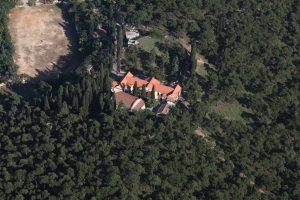 There are monasteries on both of the island’s hilltops, and there is a third on the eastern shore below Yüce Tepe, the southern peak. All three monasteries are accessible from the meydan at the waist of the island, to which one can take a fayton from the village.
There are monasteries on both of the island’s hilltops, and there is a third on the eastern shore below Yüce Tepe, the southern peak. All three monasteries are accessible from the meydan at the waist of the island, to which one can take a fayton from the village.
Isa Tepesi, the northern peak, is crowned with the monastery of the Transfiguration (Hagios Sotiros Christou). On the way up to the monastery one passes a huge wooden structure that once served as the Greek Orphanage, now abandoned and falling into ruins.
The monastery of St. George Koudonas crowns Yüce Tepe, the southernmost of the island’s two hills. A path leads up to the monastery from the meydan at the waist of the island.
The Monastery of the Transfiguration
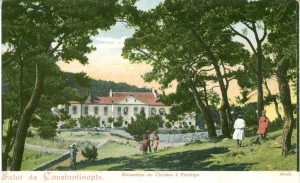 According to tradition, the monastery was founded in the Byzantine era, and implicit reference to it seems to have been made in a chrysobull issued in 1158 by the emperor Manuel I Comnenus.
According to tradition, the monastery was founded in the Byzantine era, and implicit reference to it seems to have been made in a chrysobull issued in 1158 by the emperor Manuel I Comnenus.
The monastery fell on hard times later in the Ottoman period, but it withstood these difficulties through the support of the guild of the Greek linseed oil merchants in Istanbul and an endowment from the Feneriote nobleman Pascharnikos Christodoulos Vlachoutsis. Patriarch Gregory V lived there in 1809; the former patriarch Chrysanthos moved to the monastery when he retired in 1826 and died there eight years later. Patriarch Sophronius was in residence during the years 1866-70, and through his efforts the monastery was restored and the present katholikon completed in 1869, in accordance with plans drawn by the architect Vasilis Dimitriou.
What remains of the monastery are its katholikon and an adjacent two-storey wing on its south, as well as some out-buildings on the western part of its grounds. The katholikon preserves the carved wooden iconostasis from the earlier church, gilded and decorated with floral and plant designs in both low and high relief. The doors of the Oraia Pylai are particularly notable, with eight small icons in their panels, the most remarkable being a depiction of the Annunciation, all dating from the eighteenth century. There is also a fine eighteenth-century Offertory Diptych, with Christ in the traditional Deesis representation atop the panels, flanked by the Virgin and St. John the Baptist. Set into the south exterior wall there is a replica of an ancient Greek funerary relief, dating from the second half of the nineteenth century.
The Greek Orphanage
 It is Europe’s largest wooden building, and the second largest in the world, according to Jak Deleon. The building was erected in 1898 by a French company, who planned to open it as a grand hotel called the Prinkipo Palas, with a gambling casino on the style of Monte Carlo. But Sultan Abdül Hamit II refused to give permission for such an establishment and it never opened. The building was then purchased by Eleni Zarifi, widow of the banker Leonidas Zarifi, who donated it to the Ecumenical Patriarchate on condition that it be used as an orphanage. The Greek Orphanage, which had been at Balıklı in Istanbul, reopened here in 1903, helped by a gift of 146 gold pieces donated by Abdül Hamit II, who also gave it tax-exempt status. The orphanage closed in 1964 and has since fallen into ruins, though it is still a most impressive site, one of the principal landmarks of Büyükada as seen from the sea.
It is Europe’s largest wooden building, and the second largest in the world, according to Jak Deleon. The building was erected in 1898 by a French company, who planned to open it as a grand hotel called the Prinkipo Palas, with a gambling casino on the style of Monte Carlo. But Sultan Abdül Hamit II refused to give permission for such an establishment and it never opened. The building was then purchased by Eleni Zarifi, widow of the banker Leonidas Zarifi, who donated it to the Ecumenical Patriarchate on condition that it be used as an orphanage. The Greek Orphanage, which had been at Balıklı in Istanbul, reopened here in 1903, helped by a gift of 146 gold pieces donated by Abdül Hamit II, who also gave it tax-exempt status. The orphanage closed in 1964 and has since fallen into ruins, though it is still a most impressive site, one of the principal landmarks of Büyükada as seen from the sea.
The Monastery of St. George Koudonas
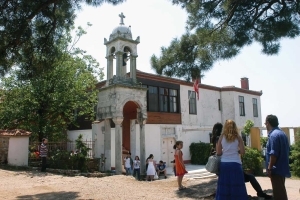 The monastery of St. George Koudonas crowns Yüce Tepe, the southernmost of the island’s two hills. A path leads up to the monastery from the meydan at the waist of the island.
The monastery of St. George Koudonas crowns Yüce Tepe, the southernmost of the island’s two hills. A path leads up to the monastery from the meydan at the waist of the island.
According to tradition, the monastery was founded in 963, during the reign of Nicephorus II Phocas (r. 963-9). The earliest reference to it is in the chrysobull of 1158 by Manuel I Comnenus mentioned earlier. The name Koudonas, which in Greek means "of the bells," comes from the story that a shepherd was grazing his flock on this hill when he heard the sound of bells coming from beneath the ground; when he dug down he found an icon of St. George, which he and other locals enshrined on the spot. This story is traditionally dated to the year 1625, and it probably represents the refounding of the monastery rather than a new foundation. Legend aside, the first abbot of record, Isaias, started building the present katholikon in 1752 and completed the main church of the Blachernitissa seven years later, also adding a number of monastic cells. Several additions were made in the following half century by the abbots Anthemios and Arsenios. Meanwhile a number of miracles were attributed to the icon of St. George, which was especially effective in curing mental ailments and in exorcizing those "driven by unclean spirits."
The present complex consists of six separate churches and chapels on three different levels, the older sanctuaries being on the lower levels. On the ground floor are the abbot’s house and the main church of St. George, both built early in the twentieth century. On the southern interior wall of the church is the original icon of Hagios Georgios Koudonas, now clad in silver. On a corner of the icon is a much later inscription, a moving appeal by a young Greek woman, who writes, "Dear St. George, help me go to Athens and study pharmacology."
A flight of steps leads to the first level below. Just beside the steps is a chapel of the Virgin Blachernitissa. Beyond that is another chapel of St. George, where iron rings set into the wall indicate that this was the place where mental patients were confined in the hope that they would be cured by the wonder-working icon of Hagios Georgios Koudonas. The room at the bottom of the stairs is a tiny shrine with an hagiasma, supposedly the place where the sacred icon of St. George was excavated. Beyond that is another chapel, dedicated to the Holy Apostles.
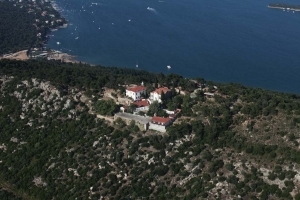 The feast day of St. George is celebrated on 23 April when thousands of pilgrims from around the world—including Muslim Turks and other non-Christians—make their way to the monastery, many of them walking barefoot up the hill to attend the dawn service. After the service many of the pilgrims have lunch at the little outdoor restaurant on the hilltop, celebrating the day that traditionally marks the beginning of spring according to the old calendar. The restaurant serves simple meals and snacks, as well as its own unlabled red wine. The hilltop is embowered in pines, cypresses, and other trees in a setting reminiscent of the Greek isles, particularly when the bells of the monastery are ringing in this ancient shrine.The feast day of St. George is celebrated on 23 April when thousands of pilgrims from around the world—including Muslim Turks and other non-Christians—make their way to the monastery, many of them walking barefoot up the hill to attend the dawn service. After the service many of the pilgrims have lunch at the little outdoor restaurant on the hilltop, celebrating the day that traditionally marks the beginning of spring according to the old calendar. The restaurant serves simple meals and snacks, as well as its own unlabled red wine. The hilltop is embowered in pines, cypresses, and other trees in a setting reminiscent of the Greek isles, particularly when the bells of the monastery are ringing in this ancient shrine.
The feast day of St. George is celebrated on 23 April when thousands of pilgrims from around the world—including Muslim Turks and other non-Christians—make their way to the monastery, many of them walking barefoot up the hill to attend the dawn service. After the service many of the pilgrims have lunch at the little outdoor restaurant on the hilltop, celebrating the day that traditionally marks the beginning of spring according to the old calendar. The restaurant serves simple meals and snacks, as well as its own unlabled red wine. The hilltop is embowered in pines, cypresses, and other trees in a setting reminiscent of the Greek isles, particularly when the bells of the monastery are ringing in this ancient shrine.The feast day of St. George is celebrated on 23 April when thousands of pilgrims from around the world—including Muslim Turks and other non-Christians—make their way to the monastery, many of them walking barefoot up the hill to attend the dawn service. After the service many of the pilgrims have lunch at the little outdoor restaurant on the hilltop, celebrating the day that traditionally marks the beginning of spring according to the old calendar. The restaurant serves simple meals and snacks, as well as its own unlabled red wine. The hilltop is embowered in pines, cypresses, and other trees in a setting reminiscent of the Greek isles, particularly when the bells of the monastery are ringing in this ancient shrine.
The view from the summit of Yüce Tepe is superb, encompassing all of the Princes’ Isles and the Asian shore of the Sea of Marmara, a prospect duly praised by Grosvenor, although the villages that he mentions have now all been amalgamated into the urban sprawl of Istanbul:
The view from this peak is the most extensive which Constantinople affords. From the height of six hundred and seventy feet the eye sweeps over the sea and comprehends the eastern shores of the Marmora. Northwest, beyond the island group, the fairy outline of Stamboul and Kadikeui fringes the sky, while the sombre point of Phanaraki advances in the foreground. North and east along the sinuous Asian coast, village presses upon village, each enriching the landscape with the tints of natural beauty or association.
More Articles...
- Büyükada - Luna Park Meydanı
- Büyükada - Important Villas and Mansion Houses You Can Encounter During Short Tour And Grand Tour Which You Can Do With A Coach Or Bicycle
- Büyükada - Center
- Heybeliada - Tour Trough the Woods, Monasteries and Çam Limanı
- Heybeliada - Center
- Burgazada - Beyond the Center
- Burgazada - Center
- Kınalıada
- Sedefadası - Antirovithos
- Museums, Cultural Centers
- Boat Tours
- Excursions and Tours
- Nightlife
- Beaches
- Bathing Water Analysis
- BÜYÜKADA - IN FRONT OF YÖRÜKALİ BEACH
- BÜYÜKADA - IN FRONT OF WATER SPORTS CLUB
- BÜYÜKADA - IN FRONT OF SEFEROĞLU FACILITIES
- BÜYÜKADA - IN FRONT OF NAKİBEY BEACH
- HEYBELİADA - IN FRONT OF WATER SPORTS CLUB
- HEYBELİADA - IN FRONT OF SADIKBEY BEACH
- BURGAZADA - IN FRONT OF WATER SPORTS CLUB
- KINALIADA - RIGHT SIDE OF PIER
- KINALIADA - LEFT SIDE OF PIER
- KINALIADA - IN FRONT OF WATER SPORTS CLUB
- KINALIADA - IN FRONT OF ÜLKER RESTAURANT
- İstanbul Long Term Average Precipitation
- İstanbul Long Term Average Sunshine Durations
- İstanbul Long Term Average Temperatures
- Age Distribution of the Population
- Hometown of the Islanders
- Population Statistics
- Distibution of the Population among the Islands
Subcategories
- Home
- Princes’ Islands
- History
- Practical İnformation
- Where To Stay
- Restaurants
- What To See
- What To Do
- F.A.Q
- Academic
-
Statistics
In this section you can find statistics collected from several offical resources.
Bathing water analysis / quality, sea temperatures, weather statistics, population and demographic statistics of the Pricess' Islands can be found here.
-
Bathing Water Analysis
This section is composed of bathing water snalysis results from measurements around the islands. These measurements are carried out around the four islands, in front of the 11 beaches during the summer season.
- Sea Temperatures
- Weather Reports
- Population and Demographics
-
Bathing Water Analysis




